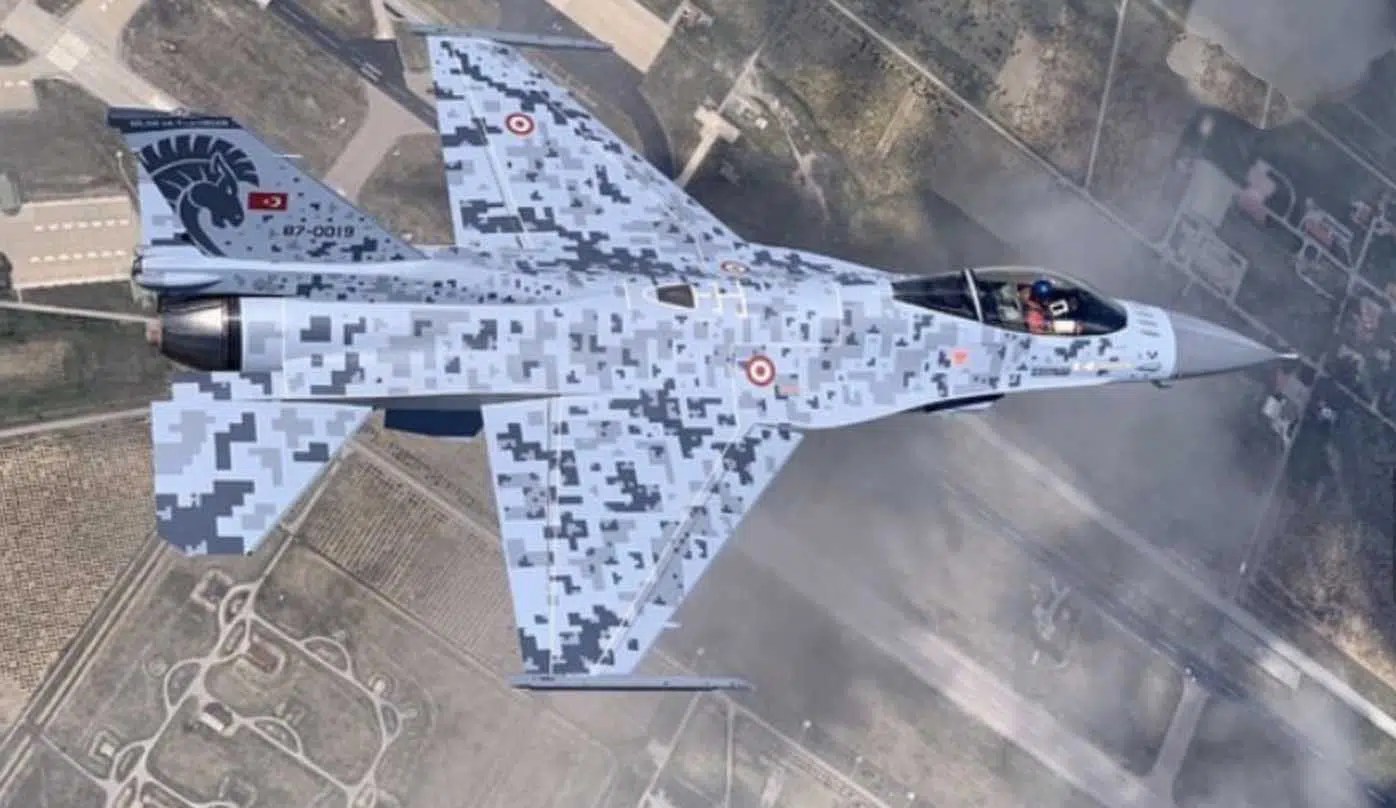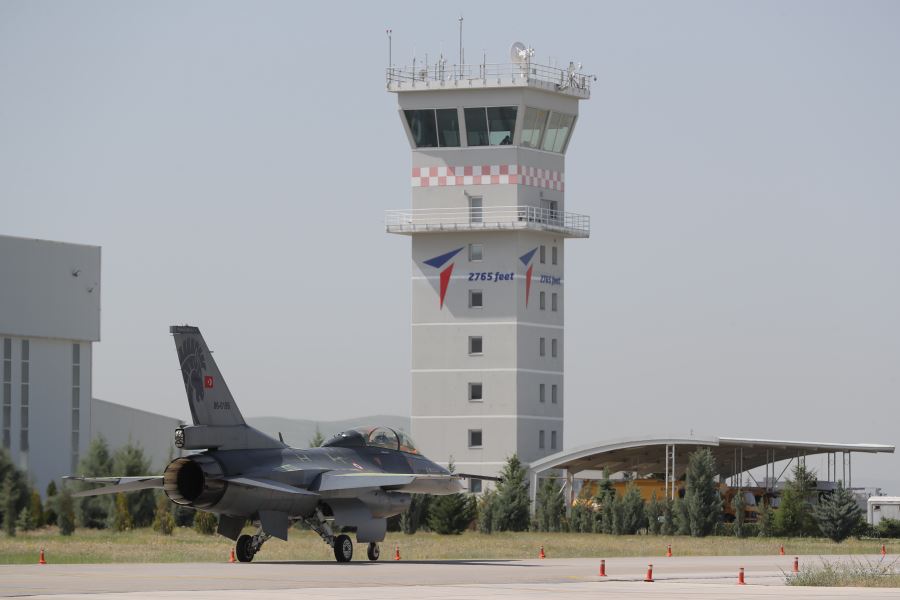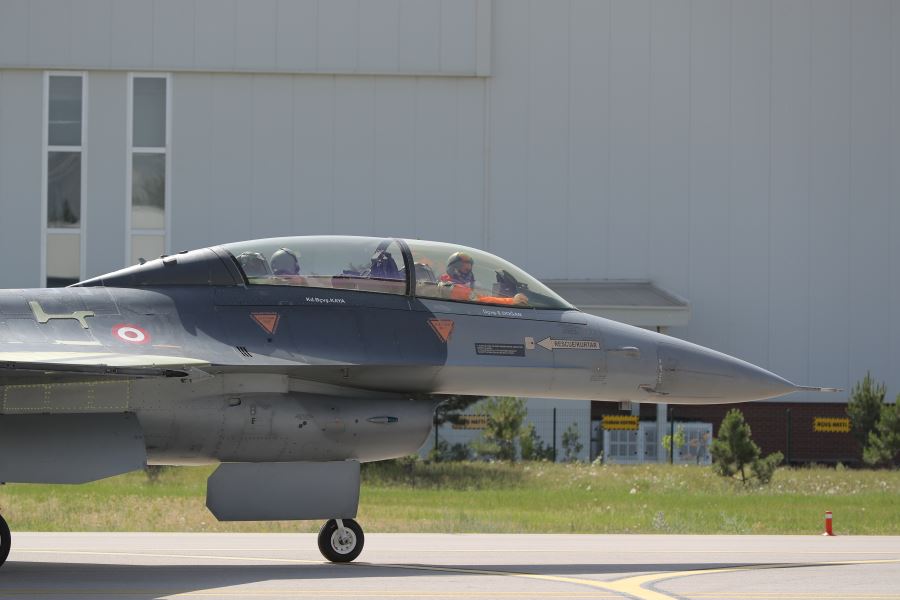dBSPL
SENIOR MEMBER

- Joined
- Mar 2, 2018
- Messages
- 7,661
- Reaction score
- 28
- Country
- Location
SSB Aircraft Department Head Abdurrahman Şeref CAN announced that they have started serial modernization on other aircrafts within the scope of the F-16 ÖZGÜR Modernization Project, in his presantation at the 9th Air and Avionic Systems Seminar.

Chairman Can said, "The modernization of Özgür on the first aircraft has been completed. Serial modernization on other aircrafts has begun."
The F-16 ÖZGÜR Project, initiated by the Presidency of Defense Industries and carried out by TAI, aims to modernize the avionics of the F-16 Block 30 fighters in the inventory of the Turkish Air Force Command.
In the ÖZGÜR project, which includes the large scale of avionic modernization* of the F-16 Block 30 jets in the Turkish Air Force inventory, and also aimed cover MURAD AESA radar integration. *(National Mission Computer, System Interface Unit, Cockpit Front Control Panel, Fuel Hydraulic Gauge, Engine Indicator Screen, Emergency System, National Sound Safety Device, National Friend - Foe Identification (IFF) System, Multimode Receiver, Inertial Navigation System, Interface Blanking Unit, Center Cockpit Indicator, Color Multi-Function Display)

Speaking within the scope of the Defense Technologies Days'21 event, organized by the Istanbul Technical University Defense Technologies Club (ITU SAVTEK) in 2021 and attended by the Defense Industry Presidency (SSB) and Turkish defense industry companies, Ahmet Akyol said that domestic AESA nose radar have better specs than the APG-83 radar F-16 b-70 Viper radar.

Ahmet Akyol, Head of Electronic Warfare and Radar Systems Department of the Presidency of Defense Industries, announced that the MURAD Aircraft/UCAV AESA Radar has entered the integration and testing phase, in his presentation at the 10th Defense Industry Days organized by the Machine Technologies Club at Yıldız Technical University.
Within the scope of the same event, Muhammet Mustafa Akkul, ASELSAN Radar Systems Engineering Director, announced the schedule regarding the national AESA aircraft radar with the following words:
“It will be a very important technological leap for our aviation. We are also developing a radar capable of active electronic scanning for our own F16s. This of course has great advantages. Especially when you enter Air Combat, it has great advantages over radars with standard mechanical steerable antennas. We will use structures that use the building blocks of this radar, such as this radar and GaN, in both Aknca and the F-16. What we learn from here, of course, creates a wealth of knowledge while making the nose radar of the National Combat Aircraft. An important technological development for us. Inshallah, we will enter Akıncı towards the end of 2021, and we will start the integration studies with the F-16 in 2022. MMU is already targeted to 2026.”

 www.savunmatr.com
www.savunmatr.com

 www.defenceturk.net
www.defenceturk.net
Aircrafts that will enter the OZGUR modernization will be those that have already undergone Structural improvement and fuselage life extension modernization.
News from January 2021 on the structural improvement program schedule:

In a statement made on his official social media account, President of Defence Industries Prof. Dr. İsmail Demir said, "Structural upgrades of F-16 Block-30 Aircraft are continuing at full speed. Within the scope of the project, engineering studies are carried out for the renovation and revision of 1200-1500 structural parts per aircraft, and necessary repair, replacement, and fuselage improvement activities are carried out. With the project carried out by Turkish Aerospace Industries, we aim to increase the structural life of our F-16 aircraft, the main striking element of our air force, from 8000 hours to 12000 hours."
During the last 20 years, Turkey has undertaken various upgrade and modification projects for the F-16 fleet. The most important of these are the ÖZGÜR Program and the F-16 Block 30 Structural Upgrade Project that started in 2010 and 2015, respectively, and are still ongoing.
The F-16 Block 30 Structural Improvement Project was initiated with the contract signed between the Presidency of Defence Industries (SSB) and the Main Contractor Turkish Aerospace (TUSAŞ) on August 10, 2015, to increase the structural life of 35 F-16C/D Block 30 Aircraft in the inventory of the Turkish Air Force (TurAF) from 8,000 hours to 12,000 hours. Since more than 7,000 hours of flight were conducted with the F-16 Block 30 fleet in service as of 2016, they were worn out in terms of structural life. Lockheed Martin also took part as a subcontractor in the project, and the 1st Air Maintenance Factory Directorate (1st AMFD) was assigned for the modernization of 10 out of 35 aircraft. Initially, the structural improvement activities on the prototype aircraft were planned to be completed in 2017, using the structural reinforcement kits developed by Lockheed Martin.
According to the information dated June 2017 on the SSB website, the modernization activities of the first aircraft were planned to be completed by the end of 2018, and the modernization of the final aircraft was expected to be completed in August 2023. With an announcement through its official social media account on July 25, 2020, the Presidency of Defence Industries (SSB) announced that the first F-16 Block 30 Aircraft's structural improvements as part of the F-16 Structural Improvement Project were completed, and following the acceptance tests, the plane was delivered to the TurAF.

 www.defenceturkey.com
www.defenceturkey.com

Chairman Can said, "The modernization of Özgür on the first aircraft has been completed. Serial modernization on other aircrafts has begun."
The F-16 ÖZGÜR Project, initiated by the Presidency of Defense Industries and carried out by TAI, aims to modernize the avionics of the F-16 Block 30 fighters in the inventory of the Turkish Air Force Command.
In the ÖZGÜR project, which includes the large scale of avionic modernization* of the F-16 Block 30 jets in the Turkish Air Force inventory, and also aimed cover MURAD AESA radar integration. *(National Mission Computer, System Interface Unit, Cockpit Front Control Panel, Fuel Hydraulic Gauge, Engine Indicator Screen, Emergency System, National Sound Safety Device, National Friend - Foe Identification (IFF) System, Multimode Receiver, Inertial Navigation System, Interface Blanking Unit, Center Cockpit Indicator, Color Multi-Function Display)

Speaking within the scope of the Defense Technologies Days'21 event, organized by the Istanbul Technical University Defense Technologies Club (ITU SAVTEK) in 2021 and attended by the Defense Industry Presidency (SSB) and Turkish defense industry companies, Ahmet Akyol said that domestic AESA nose radar have better specs than the APG-83 radar F-16 b-70 Viper radar.

Ahmet Akyol, Head of Electronic Warfare and Radar Systems Department of the Presidency of Defense Industries, announced that the MURAD Aircraft/UCAV AESA Radar has entered the integration and testing phase, in his presentation at the 10th Defense Industry Days organized by the Machine Technologies Club at Yıldız Technical University.
Within the scope of the same event, Muhammet Mustafa Akkul, ASELSAN Radar Systems Engineering Director, announced the schedule regarding the national AESA aircraft radar with the following words:
“It will be a very important technological leap for our aviation. We are also developing a radar capable of active electronic scanning for our own F16s. This of course has great advantages. Especially when you enter Air Combat, it has great advantages over radars with standard mechanical steerable antennas. We will use structures that use the building blocks of this radar, such as this radar and GaN, in both Aknca and the F-16. What we learn from here, of course, creates a wealth of knowledge while making the nose radar of the National Combat Aircraft. An important technological development for us. Inshallah, we will enter Akıncı towards the end of 2021, and we will start the integration studies with the F-16 in 2022. MMU is already targeted to 2026.”

F-16 ÖZGÜR Projesi’nde seri üretime geçildi
Savunma Sanayii Başkanlığı (SSB) Uçak Daire Başkanı Abdurrahman Şeref CAN, F-16 ÖZGÜR Modernizasyonu Projesi kapsamında diğer uçaklar üzerindeki seri modernizasyona başladıklarını duyurdu.

F-16 ÖZGÜR modernizasyonunda seri üretim aşamasına geçildi
Savunma Sanayii Başkanlığı Uçak Daire Başkanı Abdurrahman Şeref Can, F-16 ÖZGÜR modernizasyonu kapsamında seri üretime geçildiğini açıkladı.
 www.defenceturk.net
www.defenceturk.net
Aircrafts that will enter the OZGUR modernization will be those that have already undergone Structural improvement and fuselage life extension modernization.
News from January 2021 on the structural improvement program schedule:

Structural improvements of F-16 Block-30 Aircraft are continuing at full speed. Since more than 7,000 hours of flight were conducted with the F-16 Block 30 fleet in service as of 2016, a structural upgrade is required to increase the service life of these aircraft. The service life of F-16 Block 30 aircraft will be extended from 8.000 hours to 12000 hours.
January 31, 2021In a statement made on his official social media account, President of Defence Industries Prof. Dr. İsmail Demir said, "Structural upgrades of F-16 Block-30 Aircraft are continuing at full speed. Within the scope of the project, engineering studies are carried out for the renovation and revision of 1200-1500 structural parts per aircraft, and necessary repair, replacement, and fuselage improvement activities are carried out. With the project carried out by Turkish Aerospace Industries, we aim to increase the structural life of our F-16 aircraft, the main striking element of our air force, from 8000 hours to 12000 hours."
During the last 20 years, Turkey has undertaken various upgrade and modification projects for the F-16 fleet. The most important of these are the ÖZGÜR Program and the F-16 Block 30 Structural Upgrade Project that started in 2010 and 2015, respectively, and are still ongoing.
The F-16 Block 30 Structural Improvement Project was initiated with the contract signed between the Presidency of Defence Industries (SSB) and the Main Contractor Turkish Aerospace (TUSAŞ) on August 10, 2015, to increase the structural life of 35 F-16C/D Block 30 Aircraft in the inventory of the Turkish Air Force (TurAF) from 8,000 hours to 12,000 hours. Since more than 7,000 hours of flight were conducted with the F-16 Block 30 fleet in service as of 2016, they were worn out in terms of structural life. Lockheed Martin also took part as a subcontractor in the project, and the 1st Air Maintenance Factory Directorate (1st AMFD) was assigned for the modernization of 10 out of 35 aircraft. Initially, the structural improvement activities on the prototype aircraft were planned to be completed in 2017, using the structural reinforcement kits developed by Lockheed Martin.
According to the information dated June 2017 on the SSB website, the modernization activities of the first aircraft were planned to be completed by the end of 2018, and the modernization of the final aircraft was expected to be completed in August 2023. With an announcement through its official social media account on July 25, 2020, the Presidency of Defence Industries (SSB) announced that the first F-16 Block 30 Aircraft's structural improvements as part of the F-16 Structural Improvement Project were completed, and following the acceptance tests, the plane was delivered to the TurAF.

Structural Upgrade Of F-16 Blok 30 Fighter Jets Continues
Structural improvements of F-16 Block-30 Aircraft are continuing at full speed. Since more than 7,000 hours of flight were conducted with the F-16 Block 30 fleet in service as of 2016, a structural upgrade is required to increase the service life of these aircraft. The service life of F-16 Block...
 www.defenceturkey.com
www.defenceturkey.com
Last edited:








